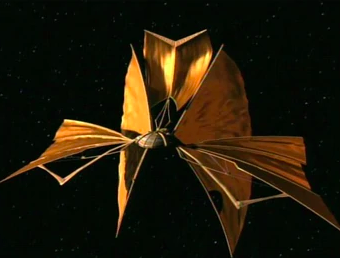The Russian Plot to Replicate the Moon

From sunrise to sunset, the world is a vibrant, living place. But when the sun goes down, zombies emerge and — no, wait, it’s not that bad. But you don’t need a horror movie scenario to understand that we’re just less productive at night than we are during the day. For generations, people have been trying to find ways to extend the light into the dark. Candles, lightbulbs, and even Daylight Saving Time have all aimed to account for the Earth spinning on its axis, effectively turning the sun off for hours at a time.
Oh, and then was the time the Russian built a massive space mirror designed to outshine the moon.
And amazingly, it worked. Kind of.
The story starts with sailboat — a space sailboat, that is. For decades, space engineers have suggested that light could push a spacecraft through the cosmos. The photons emitted by the sun have a bit of momentum — a force which, in the absence of gravity and friction, can, in theory, be used to propel a spacecraft. As Bill Nye (yes, that Bill Nye) explained in a Nat Geo essay, “since the 1920s, people have imagined spacecraft that would be so low mass and so big that the pressure of photons would push them through space the same way molecules of gas—air—push sailing ships across the sea.” The idea has even made it into Star Trek lore: early Bajorans used similar technology to travel to Cardassia, as Deep Space Nine fans know (and Cardassia tried to deny).
And in the 1980s, a Soviet engineer named Vladimir Syromyatnikov was working on the same idea. Syromyatnikov was a known commodity in the space agency space; he worked on a number of successful projects in the preceding two decades, including Vostok, the spacecraft used by Yuri Gagarin in the first manned spaceflight. Syromyatnikov wanted Russia to go where, previously, only proto-Bajorans had gone before. The Russian Space Agency didn’t have much interest in this, but they saw another way to use Syromyatnikov’s ideas. The RSA wondered if a big foil sheet in orbit could act as an artificial moon.
The idea, per the New York Times, started with the premise that “the sun is always shining somewhere on Earth” and wondered, “what if someone put a big reflector high in space to peer over the curvature of Earth, capture some of the sun’s rays and shine them down on the dark side?” As VICE explained, this would be a boon for productivity: “by shining a giant mirror onto the earth from space, they figured they could bring sunlight to the depths of night, extending the workday, cutting back on lighting costs and allowing laborers to toil longer.”
So, the Russians gave it a try. On October 27, 1992, they deployed a 20-meter wide solar mirror, bouncing sunlight back toward nighttime Earth. The experiment was a success, providing light equivalent to one moon (except for some cloud cover blocking it in some places) over a five-kilometer area. But this foil sheet wasn’t intended to be a permanent fixture among the stars — the sail was only designed to last a night or two. It fell back to Earth, burning up in the atmosphere.
Nearly seven years later, Russia went to deploy another, bigger mirror, one which would get the space agency a giant leap closer to a shiny pseudo-moon above the planet. But, as you know, we don’t have an artificial moon today. As Smithsonian reports, the “follow-up satellite got caught on one of Mir’s antennae, which ripped the delicate sail,” rendering it useless. And while they could have given it another go, they decided that the cost of continuing the project was prohibitive, and scrapped future plans instead.
But don’t give up hope — if you really want to see an artificial moon in action, you may get another chance. China is planning on launching one in 2020.
Bonus fact: What about the idea of a space sail for interplanetary travel? It may not be as farfetched as one thinks. In May of 2010, Japan’s space agency launched an experimental craft called IKAROS (“Interplanetary Kite-craft Accelerated by Radiation Of the Sun”), which is primarily powered by a solar sail. It passed by Venus that December and continued onward; Japan lost contact with it in 2015.
From the Archives: Mirror, Mirror, on the Moon: The actual mirrors on the actual moon.
